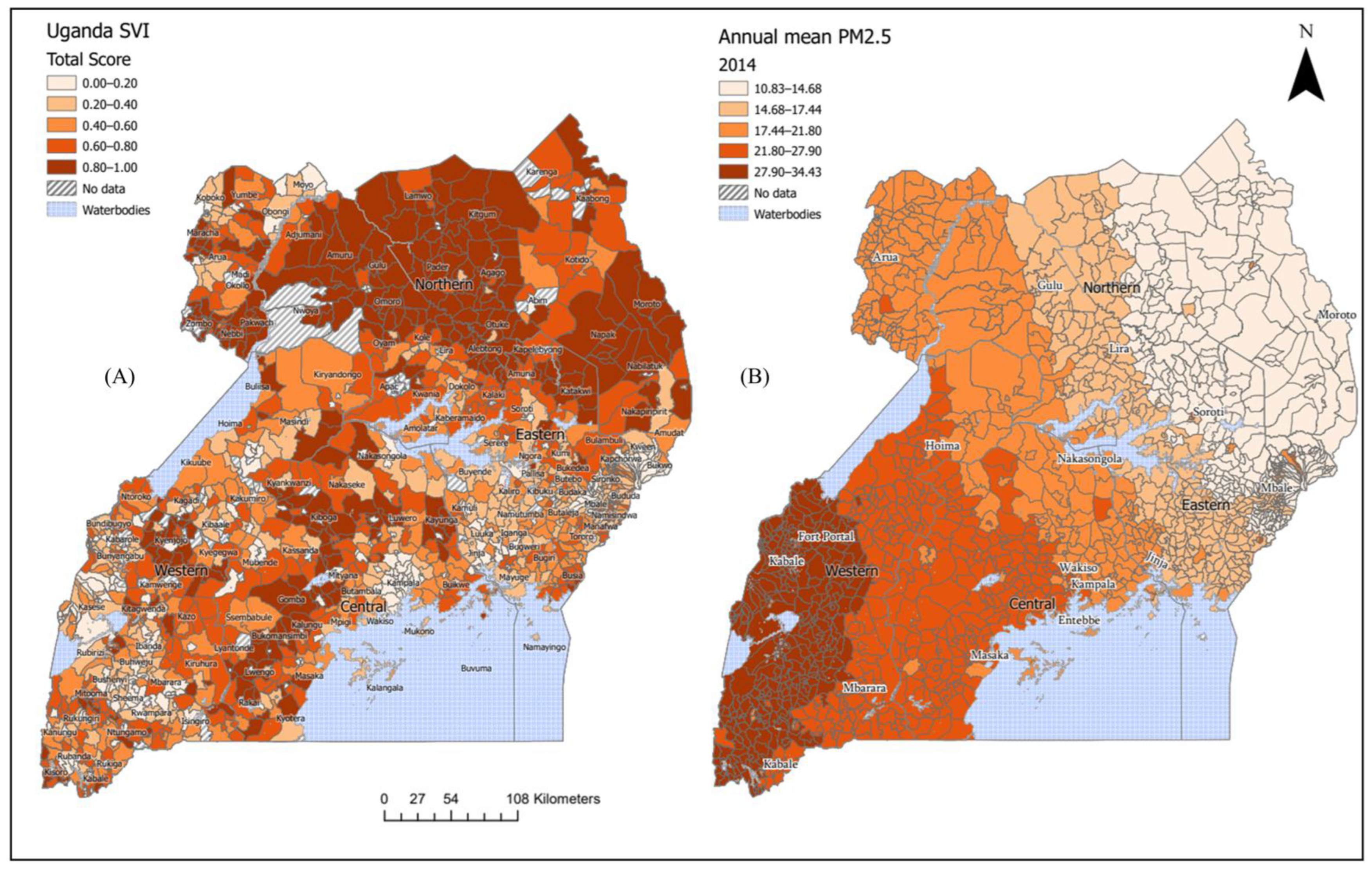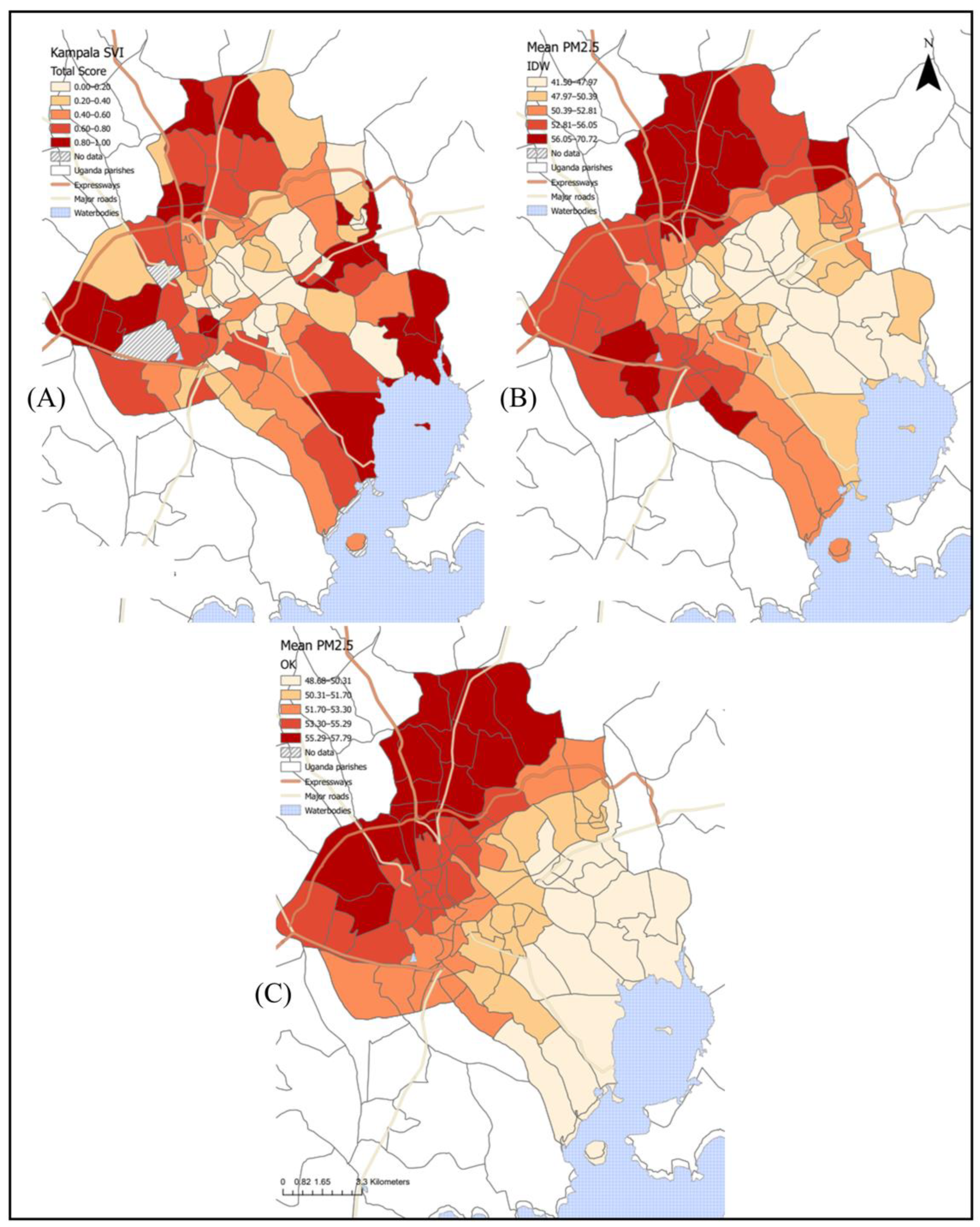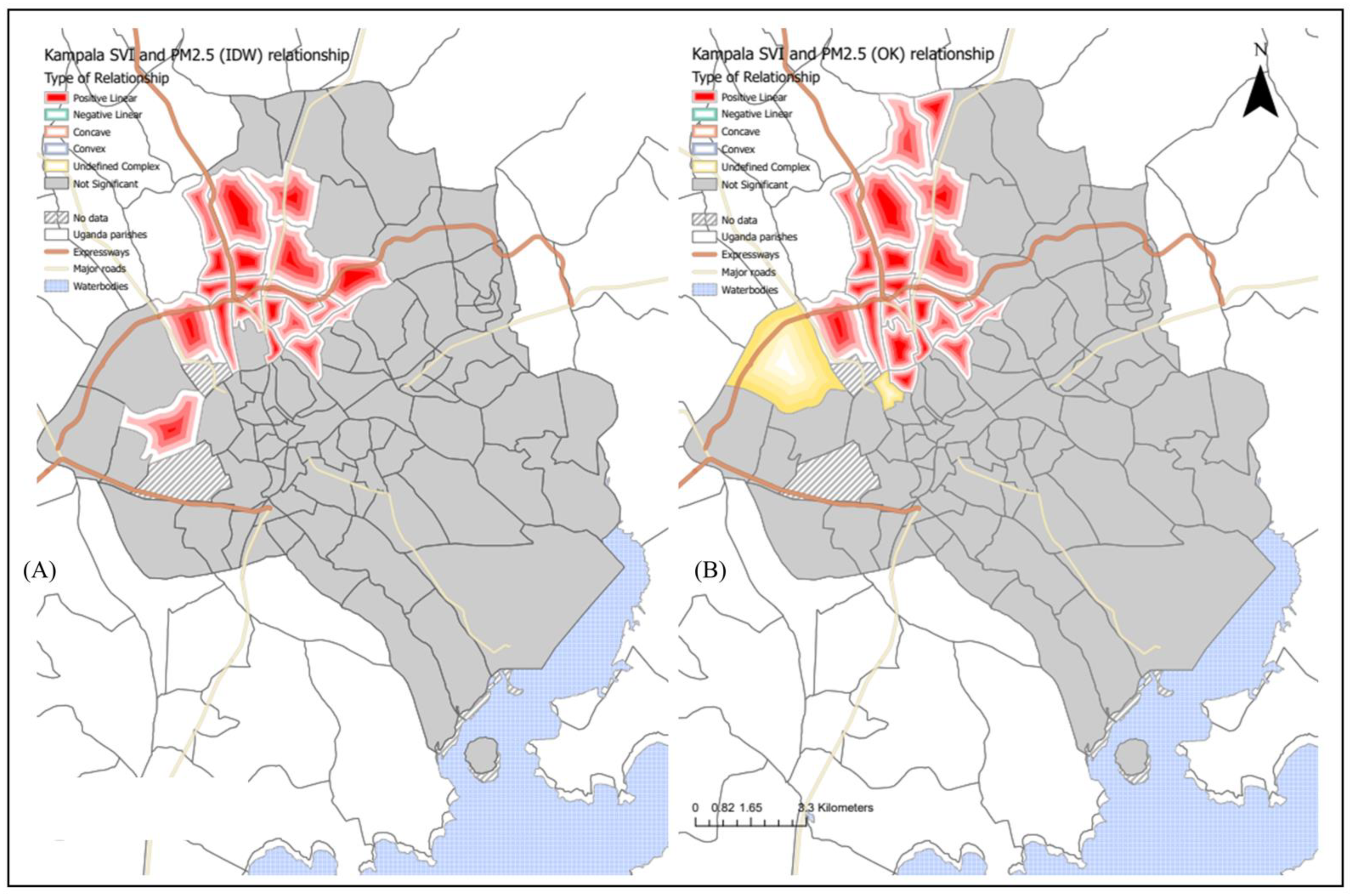A Social Vulnerability Index for Air Pollution and Its Spatially Varying Relationship to PM2.5 in Uganda
Abstract
:1. Introduction
2. Materials and Methods
2.1. Study Area
2.2. Description of Study Data
2.2.1. Uganda Bureau of Statistics Census 2014
2.2.2. Criteria for Selection of Census Variables
2.2.3. Nationwide Estimates of PM2.5
2.2.4. Ground-Level PM2.5 Monitoring Data for the Kampala Metropolitan Area
2.3. Data Analysis Processes
2.3.1. Creating the Social Vulnerability Index
2.3.2. Estimating Annual PM2.5 at the Subcounty Level
2.3.3. Estimating Annual PM2.5 within Kampala at the Parish Level Using Spatial Interpolation
2.3.4. Determining SVI Clustering among Subcounties
2.3.5. Determining Local Association between PM2.5 and SVI Score
3. Results
3.1. Nationwide Analysis
3.2. Kampala-Specific Analysis
4. Discussion
4.1. Social Vulnerability Profile and Clustering of Vulnerability across Subcounties in Uganda
4.2. Association between Nationwide Estimates of PM2.5 and SVI in Subcounties in Uganda
4.3. Association between In Situ Estimates of PM2.5 and SVI in Parishes in Kampala, Uganda
4.4. Comparison of Other Social Vulnerability and PM2.5 Studies
5. Conclusions
Supplementary Materials
Author Contributions
Funding
Institutional Review Board Statement
Informed Consent Statement
Data Availability Statement
Acknowledgments
Conflicts of Interest
References
- Bauer, S.E.; Im, U.; Mezuman, K.; Gao, C.Y. Desert dust, industrialization, and agricultural fires: Health impacts of outdoor air pollution in africa. J. Geophys. Res. Atmos. 2019, 124, 4104–4120. [Google Scholar] [CrossRef]
- Abera, A.; Friberg, J.; Isaxon, C.; Jerrett, M.; Malmqvist, E.; Sjöström, C.; Taj, T.; Vargas, A.M. Air quality in africa: Public health implications. Annu. Rev. Public Health 2021, 42, 193–210. [Google Scholar] [CrossRef] [PubMed]
- WHO HIV/AIDS | WHO | Regional Office for Africa. Available online: https://www.afro.who.int/health-topics/hivaids (accessed on 4 May 2022).
- IHME Global Burden of Disease Visualisations: Compare. Available online: https://www.thelancet.com/lancet/visualisations/gbd-compare (accessed on 4 May 2022).
- EPA Health and Environmental Effects of Particulate Matter (PM) | US EPA. Available online: https://www.epa.gov/pm-pollution/health-and-environmental-effects-particulate-matter-pm (accessed on 4 August 2021).
- Backus, L.I.; Boothroyd, D.; Deyton, L.R. HIV, hepatitis C and HIV/hepatitis C virus co-infection in vulnerable populations. AIDS 2005, 19, S13–S19. [Google Scholar] [CrossRef] [PubMed]
- Garlick, D. The vulnerable people in emergencies policy: Hiding vulnerable people in plain sight. Aust. J. Emerg. Manag. 2015, 30, 31–34. [Google Scholar]
- Brooks, N. Vulnerability, Risk and Adaptation: A Conceptual Framework. Available online: https://www.researchgate.net/publication/200032746 (accessed on 27 April 2022).
- Yang, X.; Geng, L.; Zhou, K. The construction and examination of social vulnerability and its effects on PM2.5 globally: Combining spatial econometric modeling and geographically weighted regression. Environ. Sci. Pollut. Res. Int. 2021, 28, 26732–26746. [Google Scholar] [CrossRef]
- Yang, X.; Geng, L.; Zhou, K. Environmental pollution, income growth, and subjective well-being: Regional and individual evidence from China. Environ. Sci. Pollut. Res. Int. 2020, 27, 34211–34222. [Google Scholar] [CrossRef]
- Aksha, S.K.; Juran, L.; Resler, L.M.; Zhang, Y. An Analysis of Social Vulnerability to Natural Hazards in Nepal Using a Modified Social Vulnerability Index. Int. J. Disaster Risk Sci. 2019, 10, 103–116. [Google Scholar] [CrossRef] [Green Version]
- Karaye, I.M.; Horney, J.A. The Impact of Social Vulnerability on COVID-19 in the U.S.: An Analysis of Spatially Varying Relationships. Am. J. Prev. Med. 2020, 59, 317–325. [Google Scholar] [CrossRef]
- Strader, S.M.; Haberlie, A.M.; Loitz, A.G. Assessment of NWS County Warning Area Tornado Risk, Exposure, and Vulnerability. Weather Clim. Soc. 2021, 13, 189–209. [Google Scholar] [CrossRef]
- Tate, E.; Rahman, M.A.; Emrich, C.T.; Sampson, C.C. Flood exposure and social vulnerability in the United States. Nat. Hazards 2021, 106, 435–457. [Google Scholar] [CrossRef]
- Largest Countries in Africa 2022. Available online: https://worldpopulationreview.com/country-rankings/largest-countries-in-africa (accessed on 27 April 2022).
- CIA Uganda-The World Factbook. Available online: https://www.cia.gov/the-world-factbook/countries/uganda/ (accessed on 11 July 2021).
- World Bank Group Uganda Overview. Available online: https://www.worldbank.org/en/country/uganda/overview (accessed on 11 July 2021).
- Makita, K.; Fèvre, E.M.; Waiswa, C.; Bronsvoort, M.D.C.; Eisler, M.C.; Welburn, S.C. Population-dynamics focussed rapid rural mapping and characterisation of the peri-urban interface of Kampala, Uganda. Land Use Policy 2010, 27, 888–897. [Google Scholar] [CrossRef] [PubMed] [Green Version]
- Petkova, E.P.; Jack, D.W.; Volavka-Close, N.H.; Kinney, P.L. Particulate matter pollution in African cities. Air Qual. Atmos. Health 2013, 6, 603–614. [Google Scholar] [CrossRef]
- WHO Ambient (Outdoor) Air Pollution. Available online: https://www.who.int/news-room/fact-sheets/detail/ambient-(outdoor)-air-quality-and-health (accessed on 13 July 2021).
- Coker, E.S.; Amegah, A.K.; Mwebaze, E.; Ssematimba, J.; Bainomugisha, E. A land use regression model using machine learning and locally developed low cost particulate matter sensors in Uganda. Environ. Res. 2021, 199, 111352. [Google Scholar] [CrossRef] [PubMed]
- UBOS Explore Statistics–Uganda Bureau of Statistics. Available online: https://www.ubos.org/explore-statistics/20/ (accessed on 2 December 2021).
- OCHA Uganda-Subnational Administrative Boundaries-Humanitarian Data Exchange. Available online: https://data.humdata.org/dataset/uganda-administrative-boundaries-admin-1-admin-3 (accessed on 14 January 2022).
- Ge, Y.; Zhang, H.; Dou, W.; Chen, W.; Liu, N.; Wang, Y.; Shi, Y.; Rao, W. Mapping social vulnerability to air pollution: A case study of the yangtze river delta region, china. Sustainability 2017, 9, 109. [Google Scholar] [CrossRef] [Green Version]
- Gupta, S.; Das, S.; Murty, M.N. Quantifying air pollution vulnerability and its distributional consequences. Ecol. Econ. Soc. 2019, 2, 93–125. [Google Scholar] [CrossRef]
- Muyanja, D.; Allen, J.G.; Vallarino, J.; Valeri, L.; Kakuhikire, B.; Bangsberg, D.R.; Christiani, D.C.; Tsai, A.C.; Lai, P.S. Kerosene lighting contributes to household air pollution in rural Uganda. Indoor Air 2017, 27, 1022–1029. [Google Scholar] [CrossRef]
- Richmond, A.; Myers, I.; Namuli, H. Urban informality and vulnerability: A case study in kampala, uganda. Urban Sci. 2018, 2, 22. [Google Scholar] [CrossRef] [Green Version]
- Coker, E.; Katamba, A.; Kizito, S.; Eskenazi, B.; Davis, J.L. Household air pollution profiles associated with persistent childhood cough in urban Uganda. Environ. Int. 2020, 136, 105471. [Google Scholar] [CrossRef]
- Tate, E. Social vulnerability indices: A comparative assessment using uncertainty and sensitivity analysis. Nat. Hazards 2012, 63, 325–347. [Google Scholar] [CrossRef]
- Flanagan, B.E.; Gregory, E.W.; Hallisey, E.J.; Heitgerd, J.L.; Lewis, B. A social vulnerability index for disaster management. J. Homel. Secur. Emerg. Manag. 2011, 8, 0000102202154773551792. [Google Scholar] [CrossRef]
- Clasen, T.; Smith, K.R. Let the “A” in WASH Stand for Air: Integrating Research and Interventions to Improve Household Air Pollution (HAP) and Water, Sanitation and Hygiene (WaSH) in Low-Income Settings. Environ. Health Perspect. 2019, 127, 25001. [Google Scholar] [CrossRef] [PubMed] [Green Version]
- Uganda Bureau of Statistc. The National Population and Housing Census 2014—Housing and Household Conditions Report, Kampala, Uganda. 2019. Available online: http://www.ubos.org/wp-content/uploads/publications/09_2019Housing_Monograph_-_FINAL.pdf (accessed on 27 April 2022).
- Hammer, M.S.; van Donkelaar, A.; Li, C.; Lyapustin, A.; Sayer, A.M.; Hsu, N.C.; Levy, R.C.; Garay, M.J.; Kalashnikova, O.V.; Kahn, R.A.; et al. Global Estimates and Long-Term Trends of Fine Particulate Matter Concentrations (1998–2018). Environ. Sci. Technol. 2020, 54, 7879–7890. [Google Scholar] [CrossRef] [PubMed]
- van Donkelaar, A.; Martin, R.V.; Brauer, M.; Kahn, R.; Levy, R.; Verduzco, C.; Villeneuve, P.J. Global estimates of ambient fine particulate matter concentrations from satellite-based aerosol optical depth: Development and application. Environ. Health Perspect. 2010, 118, 847–855. [Google Scholar] [CrossRef] [PubMed] [Green Version]
- Brauer, M.; Freedman, G.; Frostad, J.; van Donkelaar, A.; Martin, R.V.; Dentener, F.; van Dingenen, R.; Estep, K.; Amini, H.; Apte, J.S.; et al. Ambient air pollution exposure estimation for the global burden of disease 2013. Environ. Sci. Technol. 2016, 50, 79–88. [Google Scholar] [CrossRef]
- Okure, D.; Ssematimba, J.; Sserunjogi, R.; Gracia, N.L.; Soppelsa, M.E.; Bainomugisha, E. Characterization of Ambient Air Quality in Selected Urban Areas in Uganda Using Low-Cost Sensing and Measurement Technologies. Environ. Sci. Technol. 2022, 56, 3324–3339. [Google Scholar] [CrossRef]
- Zonal Statistics as Table (Spatial Analyst)—ArcGIS Pro | Documentation. Available online: https://pro.arcgis.com/en/pro-app/2.8/tool-reference/spatial-analyst/zonal-statistics-as-table.htm (accessed on 9 May 2022).
- ArcGIS Pro Local Bivariate Relationships (Spatial Statistics). Available online: https://pro.arcgis.com/en/pro-app/2.8/tool-reference/spatial-statistics/localbivariaterelationships.htm (accessed on 15 July 2022).
- Huang, G.; Zhou, W.; Qian, Y.; Fisher, B. Breathing the same air? Socioeconomic disparities in PM2.5 exposure and the potential benefits from air filtration. Sci. Total Environ. 2019, 657, 619–626. [Google Scholar] [CrossRef]
- Hugelius, K.; Adams, M.; Romo-Murphy, E. The power of radio to promote health and resilience in natural disasters: A review. Int. J. Environ. Res. Public Health 2019, 16, 2526. [Google Scholar] [CrossRef] [Green Version]
- Cooper, S.J.; Wheeler, T. Rural household vulnerability to climate risk in Uganda. Reg. Environ. Chang. 2017, 17, 649–663. [Google Scholar] [CrossRef]
- Aghasili, O.U. Fuel choice, acute respiratory infection and child growth in Uganda. Open Access Theses 2015, 564, 1–83. [Google Scholar]
- Heft-Neal, S.; Burney, J.; Bendavid, E.; Burke, M. Robust relationship between air quality and infant mortality in Africa. Nature 2018, 559, 254–258. [Google Scholar] [CrossRef]
- Uganda Local Government Overview | Mbale District. Available online: https://www.mbale.go.ug/lg/overview (accessed on 5 May 2022).
- Deziel, N.C.; Warren, J.L.; Bravo, M.A.; Macalintal, F.; Kimbro, R.T.; Bell, M.L. Assessing community-level exposure to social vulnerability and isolation: Spatial patterning and urban-rural differences. J. Expo. Sci. Environ. Epidemiol. 2022. [Google Scholar] [CrossRef] [PubMed]
- Malleson, N.; Steenbeek, W.; Andresen, M.A. Identifying the appropriate spatial resolution for the analysis of crime patterns. PLoS ONE 2019, 14, e0218324. [Google Scholar] [CrossRef] [PubMed]
- Fang, X.; Li, R.; Xu, Q.; Bottai, M.; Fang, F.; Cao, Y. A Two-Stage Method to Estimate the Contribution of Road Traffic to PM2.5 Concentrations in Beijing, China. Int. J. Environ. Res. Public Health 2016, 13, 124. [Google Scholar] [CrossRef] [PubMed]
- Kinney, P.L.; Gichuru, M.G.; Volavka-Close, N.; Ngo, N.; Ndiba, P.K.; Law, A.; Gachanja, A.; Gaita, S.M.; Chillrud, S.N.; Sclar, E. Traffic impacts on PM2.5 air quality in nairobi, kenya. Environ. Sci. Policy 2011, 14, 369–378. [Google Scholar] [CrossRef] [PubMed] [Green Version]
- Ouyang, W.; Gao, B.; Cheng, H.; Hao, Z.; Wu, N. Exposure inequality assessment for PM2.5 and the potential association with environmental health in Beijing. Sci. Total Environ. 2018, 635, 769–778. [Google Scholar] [CrossRef]
- Li, V.O.; Han, Y.; Lam, J.C.; Zhu, Y.; Bacon-Shone, J. Air pollution and environmental injustice: Are the socially deprived exposed to more PM2.5 pollution in Hong Kong? Environ. Sci. Policy 2018, 80, 53–61. [Google Scholar] [CrossRef]
- Milojevic, A.; Niedzwiedz, C.L.; Pearce, J.; Milner, J.; MacKenzie, I.A.; Doherty, R.M.; Wilkinson, P. Socioeconomic and urban-rural differentials in exposure to air pollution and mortality burden in England. Environ. Health 2017, 16, 104. [Google Scholar] [CrossRef] [Green Version]
- Cooper, N.; Green, D.; Knibbs, L.D. Inequalities in exposure to the air pollutants PM2.5 and NO2 in Australia. Environ. Res. Lett. 2019, 14, 115005. [Google Scholar] [CrossRef]
- Avis, W.; Khaemba, W. Vulnerability and Air Pollution. ASAP—East Africa Rapid Literature Review. Birmingham, UK: University of Birmingham. Available online: https://sciwheel.com/work/item/12119363/resources/14843553/pdf (accessed on 27 April 2022).
- Pearce, J.R.; Richardson, E.A.; Mitchell, R.J.; Shortt, N.K. Environmental justice and health: The implications of the socio-spatial distribution of multiple environmental deprivation for health inequalities in the United Kingdom. Trans. Inst. Br. Geogr. 2010, 35, 522–539. [Google Scholar] [CrossRef] [Green Version]
- Buzzelli, M. Modifiable areal unit problem. In International Encyclopedia of Human Geography; Elsevier: Amsterdam, The Netherlands, 2020; pp. 169–173. ISBN 9780081022962. [Google Scholar]




| Theme | Variable | Definition |
|---|---|---|
| Age dependency | Youth dependency ratio | The ratio of those aged 0–4 years to the population aged between 15 and 64 years |
| Old-age dependency ratio | The ratio of those aged 65 years and above to the population aged between 15 and 64 years | |
| Social | Children 0–17 who lost at least one parent | Percentage of children (0–17 years old) who have lost a parent |
| 2 years plus with disability | Percentage of individuals who are 2 years old and above who live with a disability | |
| 50 years plus widowed | Percentage of individuals who are 50 years old and above and are widowed against the total adult population | |
| Housing | Temporary dwelling unit | Percentage of total households that live in units that are built using temporary materials for the roof, wall, and floor |
| Households that are renter occupied | Percentage of total households that are renter occupied Inverse of the variable “households that are owner occupied” used | |
| Health | Distance to any health facility (5 km or more) | Percentage of total households that live more than 5 km away from the nearest health facility |
| Do not have access to piped water | Percentage of total households that do not have access to piped water Inverse of the variable “access to piped water” used | |
| Without access to borehole | Percentage of total households that do not have access to borehole (well-water source) Inverse of the variable “with access to borehole” used | |
| Without any toilet facility | Percentage of total households that do not have any toilet facility Inverse of the variable “with any toilet facility” used | |
| Households that (all members aged 5+ years) consume fewer than two meals a day | Percentage of total households where members who are 5 years old and above consume fewer than two meals a day | |
| Communication | Households that do not own a television (TV) | Percentage of total households that do not own a TV |
| Households that do not own a radio | Percentage of total households that do not own a radio | |
| Population 18+ illiterate | Percentage of the adult population (18+) that is illiterate | |
| Economy | 18 years plus not working | Percentage of the adult population (18 years and above) that does not work Inverse of the variable “working 18 years and older” used |
| Households where no member possesses a bank account | Percentage of total households where no member has a bank account Inverse of the variable “households where any member possesses a bank account” used | |
| Households depending on subsistence farming | Percentage of total households that depend on subsistence farming (farmers grow enough to feed their families, not to make a profit) | |
| Air quality | Households that do not properly dispose of solid waste | Percentage of total households that do not dispose of solid waste properly Inverse of the variable “households that properly dispose of solid waste” used |
| Households’ main source of lighting is tadooba | Percentage of total households that use tadooba (a thick-wick lamp) as their main source of lighting | |
| Households using polluting fuel for cooking | Percentage of households that use polluting fuel (paraffin, firewood and charcoal, grass or cow dung, and others) |
Publisher’s Note: MDPI stays neutral with regard to jurisdictional claims in published maps and institutional affiliations. |
© 2022 by the authors. Licensee MDPI, Basel, Switzerland. This article is an open access article distributed under the terms and conditions of the Creative Commons Attribution (CC BY) license (https://creativecommons.org/licenses/by/4.0/).
Share and Cite
Clarke, K.; Ash, K.; Coker, E.S.; Sabo-Attwood, T.; Bainomugisha, E. A Social Vulnerability Index for Air Pollution and Its Spatially Varying Relationship to PM2.5 in Uganda. Atmosphere 2022, 13, 1169. https://doi.org/10.3390/atmos13081169
Clarke K, Ash K, Coker ES, Sabo-Attwood T, Bainomugisha E. A Social Vulnerability Index for Air Pollution and Its Spatially Varying Relationship to PM2.5 in Uganda. Atmosphere. 2022; 13(8):1169. https://doi.org/10.3390/atmos13081169
Chicago/Turabian StyleClarke, Kayan, Kevin Ash, Eric S. Coker, Tara Sabo-Attwood, and Engineer Bainomugisha. 2022. "A Social Vulnerability Index for Air Pollution and Its Spatially Varying Relationship to PM2.5 in Uganda" Atmosphere 13, no. 8: 1169. https://doi.org/10.3390/atmos13081169
APA StyleClarke, K., Ash, K., Coker, E. S., Sabo-Attwood, T., & Bainomugisha, E. (2022). A Social Vulnerability Index for Air Pollution and Its Spatially Varying Relationship to PM2.5 in Uganda. Atmosphere, 13(8), 1169. https://doi.org/10.3390/atmos13081169








